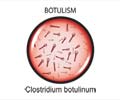Scientists have discovered new details about how 'cloaking' proteins protect the toxin that causes botulism.

‘The knowledge about the cloaking proteins that protect the toxin which causes botulism might now be turned against the toxin to deliver vaccines or drugs that could prevent or treat the disease.’





Though there are seven different types of botulinum toxin, all are released from Clostridium botulinum bacteria as a complex of the toxin plus at least one such associated protein. When people eat contaminated food, the toxin/associated-protein complex stays together in the digestive system, but splits apart to free the toxin once it moves into the bloodstream, where it goes on to disable nerve cells, causing paralysis and death. Brookhaven Lab biologist Subramanyam Swaminathan, lead author on the paper, said, "We wanted to know how the toxin is protected, how the complex stays together in the harsh acidic environment of the human gastrointestinal (GI) tract, and how the toxin comes out once it leaves the GI tract and enters the bloodstream."
The atomic-scale structures reveal the detailed mechanism of how the toxin/associated-protein complex is assembled and stays intact under acidic conditions, and also how it disassociates when it enters the neutral pH conditions of the blood.
Swaminathan said, "As the pH changes to neutral, some of the acidic amino acids at the interface between the two proteins-the toxin and the associated protein-become negatively charged. The repulsion between the negative charges causes the toxin and the associated protein to separate, leading to the dissolution of the complex and the emergence of the active toxin."
The structures also revealed a strong similarity with one of the complexes formed by another botulinum neurotoxin, suggesting that there may be common elements across all seven varieties in the complex stage.
Advertisement
One promising approach, the scientists say, would be to use the toxin's own cloaking system to develop vaccines or drugs. For example, the cloaking proteins might be used to deliver inactive forms of the toxin that could trigger a protective immune response in the bloodstream-in other words an easily administered oral vaccine.
Advertisement
New treatments would certainly help mitigate the fears of home food canners-not to mention those concerned that botulinum neurotoxin might be used as a weapon of bioterror.
Source-Eurekalert















